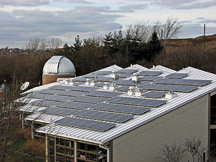Secaucus residents are still six months away from seeing the town outfitted with solar panels on school buildings and other municipal properties, and a regionwide plan to expand renewable energy is moving forward.
Working with the Town of Little Ferry, Secaucus will soon begin seeking bids from contractors as part of a regional solar energy plan that should trim electricity costs for the municipality and taxpayers.
“I think the system is supposed to generate about 1,592 kilowatt hours and we’re hoping to see an energy savings of somewhere between a 15 and 30 percent for those particular energy locations,” said Town Administrator David Drumeler last week.
He said that the energy produced by the system will not be sold off to other customers, but will be used completely by municipality and Secaucus Public School District. (The town requested that video monitors also be included in whatever system is installed so that the school system can see how much energy is being generated at any given time and can use the system for educational purposes.)
“We’re hoping to see an energy savings of somewhere between a 15 and 30 percent.” – David Drumeler
________
The municipal lots, located at Town Hall and across the street from Huber Street School, will be given canopies on which solar panels will be installed so that parking spaces are not lost.
Under the Municipal Solar Assistance Program, launched in 2008, the NJMC offers free assistance to Meadowlands District communities that are interested in converting to renewable energy resources. Through the program, the NJMC, a state agency, offers financial and technical assistance to communities that would like to install solar arrays on schools and municipal properties.
Now that sites for panels have been chosen, the next step is to figure out how energy companies and municipalities like Secaucus might develop “power purchase agreements.” The agreements would lay out the terms by which vendors would install the panels at the approved sites and sell the energy back to the municipality at rates that are cheaper than traditional energy costs. The next stage would be to find those vendors with an interest in renewable energy and have them install the panels.
The vendor generates profits by selling “renewable energy” to the municipality.
The municipality and taxpayers would benefit as well. Since renewable energy is cheaper than traditional energy sources, the town and school district would have reduced energy costs, thus saving taxpayer dollars. Assuming the municipality locked in a long-term contract with the vendor, the town could also benefit from having stable and predictable energy costs.
Other Meadowlands District towns are also participating in the program, including Little Ferry, Carlstadt, Moonachie, Rutherford, South Hackensack, and Teterboro.
Ahead of scheduled state mandates
As a part of its Municipal Solar Assistance Program, the NJMC spent nearly two years evaluating rooftops throughout the Meadowlands District to see which ones might be best used for renewable energy. The NJMC, a state agency, underwrote all costs associated with this analysis.
Agency officials said they tried to undertake this plan ahead of upcoming state mandates. Under New Jersey’s Energy Master Plan, 30 percent of the state’s electricity must come from sustainable energy sources, such as sun or wind, by 2020. And by law, New Jersey must generate 4,335 megawatts of state-based solar energy by 2026.
“The NJMC’s Municipal Solar Assistance Program can help Meadowlands towns reap the benefits of using clean, low-cost solar power without having to spend taxpayer dollars,” said NJMC Executive Director Robert Ceberio. “The program is an excellent example of how the commission strives to use its resources to help reduce local government costs and improve residents’ quality of life.”
Next steps
With the first phase of the Municipal Solar Assistance Program – the selection of locations – now completed, the NJMC is moving into the next phase of the program.
The agency is already exploring ways to set up power purchase agreements with potential vendors.
Although in its initial phase the state agency worked with only a handful of municipalities, it has now expanded the program to all 14 of the state-designated Meadowlands District towns. The NJMC believes the region will benefit most by having a larger-scale program than what was initially planned. The program also will now include solar panels at ground level, in addition to ones on rooftops.
E-mail E. Assata Wright at awright@hudsonreporter.com.
